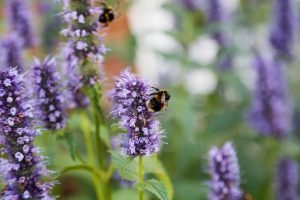
A sensory garden is a garden, or part of a garden, which is specifically designed to appeal to the five senses through the use of soft and hard landscaping. The Sensory Trust defines a sensory garden as “a self-contained area that concentrates a wide range of sensory experiences. Such an area, if designed well, provides a valuable resource for a wide range of uses, from education to recreation.”
Sensory gardens are increasingly popular for outside spaces in schools, hospitals and hospices to create a relaxing and therapeutic environment. In fact it’s been proved that sensory gardens have therapeutic value for people with visual disabilities or dementia who can enjoy connecting with nature in a safe environment. Sensory gardens can also contribute positively to emotional wellbeing and can be used as a coping strategy to improve mental, emotional and long term physical health.
They can also be beautiful places to relax, reflect, meditate, contemplate and talk.
The importance of sensory gardens in the workplace is increasingly being recognised by employers to help reduce stress, restore attention and improve productivity. Research by architects also points to nature and multi-sensory experiences being key to office workers’ health wellbeing and productivity.
Engaging the senses has benefits for everyone, whether it helps you to relax, is a fun space for children to play or just encourages people to be out in the garden! The great thing about sensory gardens is that elements can be incorporated into any space, with all five senses able to be dispersed throughout the garden or concentrated in a dedicated sensory area.
Most people’s first thought when they think about their dream garden is what it will look like, but even within ‘sight’ there are many options to consider. The colours of plants in the garden is an obvious consideration, but you may also want to think about hard landscaping materials, such as decking or paving, which can come in a variety of colours from light sandstone to dark, shiny slate or a dark, hardwood decking. Thinking about the colours of these materials can create a softer look or a striking contrast. You may also think about varying heights of planting, having a mixture of different features as well as a variety of shapes; from a smooth, curved patio, to angular cubic planting containers. All of these elements can create a more visually interesting garden.
When it comes to sound in your garden, why not combine the natural with state of the art sound equipment and truly awake the senses. There are plenty of ways that natural sounds can be incorporated in your garden, from trickling water features, swishing grasses to birdsong; however if you like to work out to music or just don’t want to rely on nature to create ambience, then a sound system may be the answer. There are a variety of sound systems which are specifically designed for outdoor use and can be carefully concealed within your garden, allowing you to enjoy high quality sound without the inconvenience of loose wires and ugly speakers.
Smell can be one of the most stimulating senses so having a variety of scents is an important aspect of a sensory garden. There are many different types of scent that can be included in a garden. Some plants, like Mexican orange blossom, release a fragrance when you rub the leaves, this is similar to herbs like mint and thyme. A herb and vegetable garden is a great way to stimulate many of the senses. Honeysuckle, lavender and sweet pea plants are other classic examples of plants which produce fragrance in your garden.
Naturally, all plants and surfaces in the garden vary in their texture, you may like to choose elements with contrasting textures, such as spiky grasses compared to soft Lamb’s ear. Or you may want more subtle differences such as Lamb’s ear and the cotton wool-like down of Silver sage. Similarly, textures of hard landscaping features can vary, for example, rough, Yorkstone walling or smooth slate.
Tastes in the garden don’t just have to come from the veg beds. Herbs such as Spearmint and Rosemary are great to use in cooking, and plants like Nasturtium have beautiful flowers which are edible. Even herbs like Chives, whose foliage can be used in salads, also produces a flower which can be eaten.
By incorporating elements to appeal to your senses into the garden you can create a space which is specifically catered to your needs; be it a place to relax, work out, or socialise. Whether you want a dedicated sensory garden or would just like a garden which connects with the senses, now is a great time to review what you want your garden to do for you.
If you’d like to find out how you can create a sensory haven in you garden, give us a call on 01491 280447 or email info@greenart.co.uk










